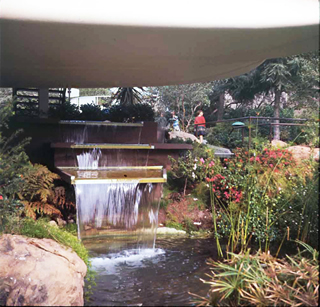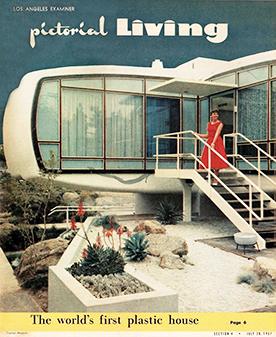Plastic Fantastic Living - Page 6
 |
|
|
 |
|
|
“Fifty or more people can move about inside the house,” the New York Times said, “without vibrating it in the least.”
In the MIT report on the house, the designers reached an important conclusion: “It is feasible to design and construct large structures made from plastics material which will perform their engineering function in a satisfactory manner. The result, although not altogether faultless, is felt to be a valid step in the direction of the collaboration necessary to enable architecture, industry, and technology to maintain pace with the needs of HUMAN BEINGS.”
Popular it may have been, but as we know, the House of the Future became the ‘House of the Past’ in 1967. But it fought hard to survive.
“Neither steel balls, torches, chain saws, nor jackhammers were able to help the wreckers,” a reporter recalled, two years after the house came down. “What finally solved their problem, after two weeks of effort, were choker cables that tore the modules into pieces small enough so they could be carted away.”
Goody himself outlived the house by less than a decade and a half. An avid sailor, he died of a heart attack at the helm. MIT twice a year provides an award in his name “to extend the horizons of existing building techniques and use of materials,” and the firm he founded, Goody Clancy, continues to win honors.
Plastic has yet to become the material of choice for homes. In the late 1960s, when the house came down, folks in the industry blamed a lack of understanding among designers [the same problem the House of the Future was designed to eliminate], troublesome local building codes, the “attitude of labor unions,” and pending environmental regulations regarding disposal of chemical waste.
One exec admitted that “structural plastics have a way to go” as an architectural material.
Although few of us today live in a plastic house, many of us live with plastic components, including Kirwan and his wife Constance, who recently installed a prefabricated plastic Jacuzzi walk-in tub in their home near Harvard Square.
“As a social progressive, I did not think [the House of the Future] was very successful in accomplishing what I would have liked to see it do,” Kirwan says. “But it was influential in getting people to use plastics in architecture.”
• Special thanks to Mickey McGowan of the Unknown Museum and David Eppen of GorillasDontBlog.blogspot.com for their archival assistance
Photos: Ernie Braun, David Eppen; and courtesy Goody Clancy, Ernest Kirwan, Monsanto Company, Walt Disney Company, Los Angeles Examiner




